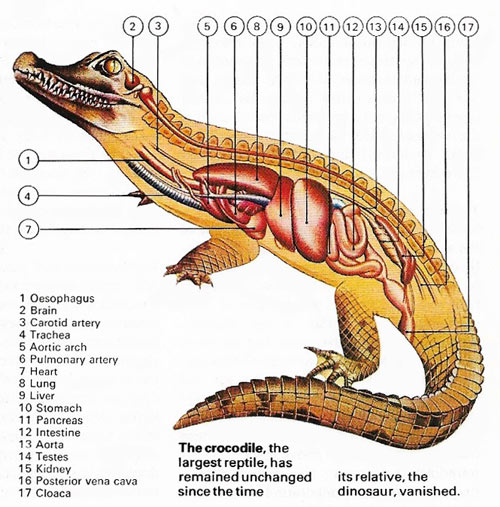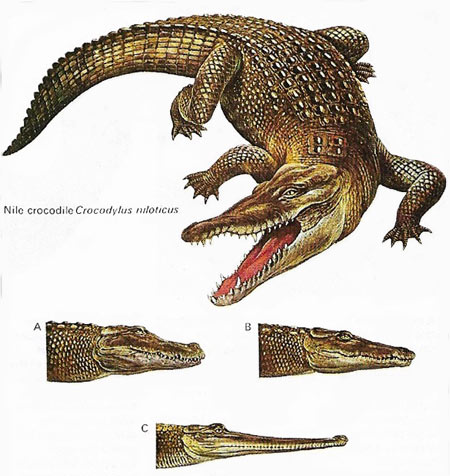Crocodilia

Figure 1. The crocodile, the largest reptile, has remained unchanged since the time its relative, the dinosaur, became extinct.

Figure 2. Large alligators (A) and crocodiles (B) are powerful enough to kill and feed on animals up to the size of a cow. The specialized gharial (C) has long, thin jaws which it swings from side to side snapping at fish in the vicinity.
Crocodilia is an order of reptiles (class Reptilia) that includes alligators and crocodiles. The crocodilians have short legs which are clumsy on land but long tails that enable them to swim powerfully. Alligators are distinguished from crocodiles by the arrangement of their teeth.
Crocodiles and alligators are found in lakes and rivers throughout the tropics, using their muscular, flattened tails for driving themselves through the water and their webbed feet for steering. One species, the estuarine crocodile (Crocodilus porosus) makes its way to the sea. The sharp, conical teeth with which crocodiles and alligators are armed are good for seizing their prey but less efficient at cutting up a carcase; to overcome this drawback the crocodile will spin over in the water with its victim in its grasp, until part is torn off. It keeps its sharp bite into old age for it continually grows new teeth to replace the old ones. The alligator differs from the crocodile in its dentition. The large fourth tooth of a crocodile's lower jaw sticks up inside the upper jaw whereas, in the alligator, it disappears into a pit inside the jaw (Figure 2).
Senses
Crocodilians have reasonable eyesight, with the slit pupils characteristic of nocturnal animals, but cannot distinguish colors. Their hearing is good and their sense of smell is probably adequate.
Reproduction
Crocodiles and alligators may lay up to 100 eggs in a clutch, the eggshells being hard rather than leathery. The eggs are fertilized within the female before laying. The males have a single intromittent organ, which is turned outwards from the genital opening, the cloaca, for mating. The young, once hatched, may grow an average of 2.5 centimeters (1 inch) a month for the first three years of their life.


